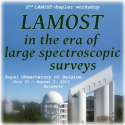Description
Parameter determination
Dr
Anbing Ren
(Beijing Normal University)
31/07/2017, 16:30
2.2 The LAMOST as a large spectroscopic survey
Invited talk
All of the 14 subfields of the Kepler field have been observed at least
once with the Large Sky Area Multi-Object Fiber Spectroscopic Telescope
(LAMOST, Xinglong Observatory, China) during the 2012-2014 observation
seasons. There are 88,628 reduced spectra with SNR$g$ (signal-to-noise ratio in $g$ band) ≥ 6 in the database of the LAMOST-Kepler project (LK-project). By adopting the upgraded...
Dr
Antonio Frasca
(INAF - Osservatorio Astrofisico di Catania)
31/07/2017, 17:00
2.2 The LAMOST as a large spectroscopic survey
Invited talk
We present the results of the analysis of LAMOST spectra in the Kepler field with the ROTFIT pipeline. The application of our code to these spectra has allowed us to perform an MK spectral classification and to derive the atmospheric stellar parameters (Teff, logg and [Fe/H]). Moreover, we have also measured the radial velocity of the targets and provide an estimate of the projected rotational...
Dr
Christopher Corbally
(Vatican Observatory), Dr
Richard Gray
(Department of Physics and Astronomy, Appalachian State University)
31/07/2017, 17:30
2.2 The LAMOST as a large spectroscopic survey
Invited talk
We have reported the accurate two-dimensional spectral classifications obtained with the expert code, MKCLASS, for the first set of Kepler region spectra from LAMOST (Gray et al. 2016). Here we update how these classifications have been used since for science. In particular, we note how they have led to four confirmed lambda Bootis-type stars with pulsation in both p- and g-modes. These have...
Mrs
Filiz Kahraman Alicavus
(Canakkale Onsekiz Mart University)
01/08/2017, 10:00
2.2 The LAMOST as a large spectroscopic survey
Contributed talk
In this study, the results of low-metallicity pulsating stars' research are presented. The stars were selected from the LAMOST DR1 catalogue considering the ranges of [6500:8600] K, [3.6:4.8] dex, and [-2.4:-0.5] dex of effective temperature T_eff, surface gravity logg, and metallicity [Fe/H], respectively. Photometric data of the selected stars were taken from WASP. The stars showing light...
Dr
Lester Fox-Machado
(Instituto de Astronomia-Universidad Nacional Autonoma de Mexico (UNAM))
01/08/2017, 10:20
2.2 The LAMOST as a large spectroscopic survey
Contributed talk
We present low and medium resolution spectroscopy of a number of stars in the kepler-field-of-view obtained in the past few years during several runs at the Observatorio Astronomico Nacional-San Pedro Martir (OAN-SPM) in Baja California, Mexico. The Boller & Chivens spectrograph installed in the Cassegrain focus of the 2.12-m telescope has been used. The atmospheric parameters of the stars...
Mr
Jie Yu
(University of Sydney)
01/08/2017, 10:40
3.1 Science with the LAMOST
Contributed talk
The Kepler mission has provided exquisite data to perform ensemble asteroseismic analysis on evolved stars. In this work we systematically characterize the oscillation power excess for 16,136 oscillating red giants, using full-length long-cadence data. We produced a homogeneous catalog of seismic masses, radii, and surface gravities and investigated the properties of the oscillation power...

